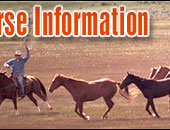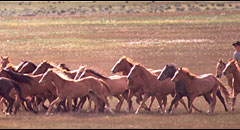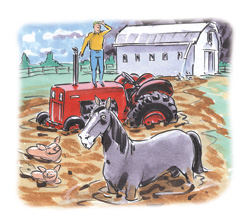 |
   |
|
|
|
You are here: Horses > Horse care > Muddle America |
Dealing With Mud
As a horse owner you have likely spent a lot of time sloshing around in a
paddock while trying to catch a horse. A beautiful palomino horse may turn into
the color of strong coffee after such an exercise. You then have a choice
between two fun parts, the muddy paddock and the filthy horse.
|
|
|
For a horse, mud can be an unhealthy environment. Bacteria and fungi
are harbored in mud which can cause abscesses, scratches, rain scald and
thrush. Insects such as mosquitoes and flies also breed in mud. Dirt of
sand particles can be ingested by horses that are fed on muddy ground
which can lead to sand colic. Injuries to the horse and humans can result
from the slick, unsafe footing that is caused by mud.
The environment is also potentially harmed by mud. Mud that is enriched by
manure can harm the aquatic life if it gets into streams |
and ponds. This is not only a concern for those who live near
creeks or lakes since the nutrients and sediments can also cause issues
with groundwater and this can be a big problem if you draw from a well.
 An
increase of surface water is a recipe for creating mud such as rain off the
roof of the barn or any runoff from the driveway. If you barn is in a place
where the soil doesn’t drain very well then you are going to have highly
organic soil. Manure that is built up from decomposed organic material such as
stall waste, shavings or spent hay are also added to the mix. Then there are
the added issues of where it is such as the high traffic areas in front of a
stall, on top of a compacted and impervious surface such as in front of a gate.
All this can bring about mud. An
increase of surface water is a recipe for creating mud such as rain off the
roof of the barn or any runoff from the driveway. If you barn is in a place
where the soil doesn’t drain very well then you are going to have highly
organic soil. Manure that is built up from decomposed organic material such as
stall waste, shavings or spent hay are also added to the mix. Then there are
the added issues of where it is such as the high traffic areas in front of a
stall, on top of a compacted and impervious surface such as in front of a gate.
All this can bring about mud.
However, there are several options to fight against mud. The first step is to
make sure horses are fenced out of creeks, wetlands and lakes. You can provide
your livestock with easy, cost-effective watering systems while protecting any
open bodies of water.
It is important to always make sure you practice good pasture management. The
golden rule of pasture management in the summer is to not graze below three or
four inches. Important components of good pasture management are cross fencing
and controlled grazing.
Techniques such as a fenced “sacrifice area” where you place your horses during
saturated soils and frozen pastures is important for winter pasture management.
The health of next summer’s pasture relies on keeping horses off frozen or
soggy pastures and allows you to avoid the muddy mess between times.
Every few days you should pick up the manure in the paddocks and the sacrifice
area. This not only decreases the build-up of mud but it will also reduce the
chance of parasite re-infestation. Picking up stray clumps of bedding and
leftover hay is also a good idea. Eventually all organic material will
decompose and lead to mud.
To divert rainwater away from confinement areas you should install gutters and
downspouts on all buildings. A two-stall run-in shed can have as much as
fourteen gallons of rainwater run off in a year. The amount of mud will be
greatly reduced if you divert that much water away from the paddock and you
will help the environment by keeping clean rainwater clean. Rainwater should be
diverted to grassy ditches, dry wells, rain barrels, stock watering tanks,
ponds, well-vegetated woods or to any unused portions of pasture.
To keep horses off the dirt and allow the rainwater to percolate you should use
footing in paddocks and high traffic areas. Chipped wood products,
gravel/crushed rock, or sadness at least three inches of footing in your
paddock are popular choices. To see what products are available and what others
have used successfully you should check your local stores.
Consider laying down filter fabric before installing footing material if you
have soil that is very organic and mucky. A woven plastic used in construction
projects that has small holes in the material will allow water, but not sand or
silt, to pass through. Your local conservation district, the Natural Resources
Conservation Service, the Cooperative Extension Office or the web can be used
to help with design.
You manure pile should always have a tarp. The compost will retain the
nutrients you are trying to save and won’t get into the surface waters where
they cause problems. Manure should be stored as far away from streams, ditches
or wetlands as possible so that you can avoid mud problems and any potential
environmental impacts.
Native trees and shrubs should be planted and maintained. 100 to 250 gallons of
water per day can be absorbed by a mature Douglas fir. Evergreens will also use
water in the winter when other deciduous trees are dormant. Along the outside
of paddocks you should use water-loving native shrubs so that you can keep the
area drier and reduce the amount of runoff. You should protect the trees in
pasture and paddocks from chewing and root compaction.

|
Read the next horse care article on Keeping Owners Safe: Equine Safety Tips. |
|
|
|
|
 |
|
|
|
|
|
Horse Education
|
|
|
|
|
Horse Information Topics
|
|
|
|
|
|
|
|
Horse Business Owners
|
| |
Advertise with Us
Have your horse products or services exposed to over 27,000 of our monthly visitors.
|
|
|
|
|
|